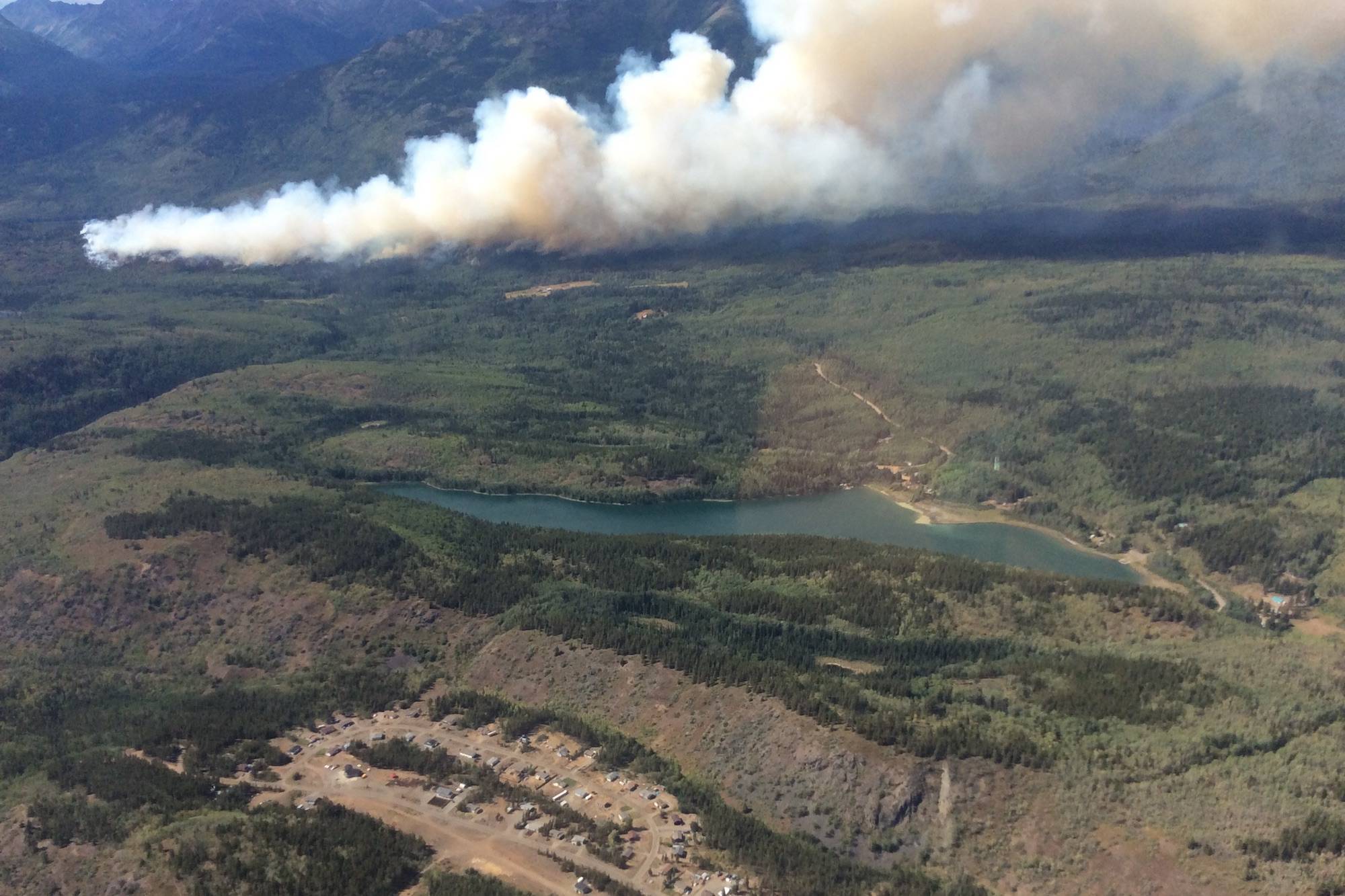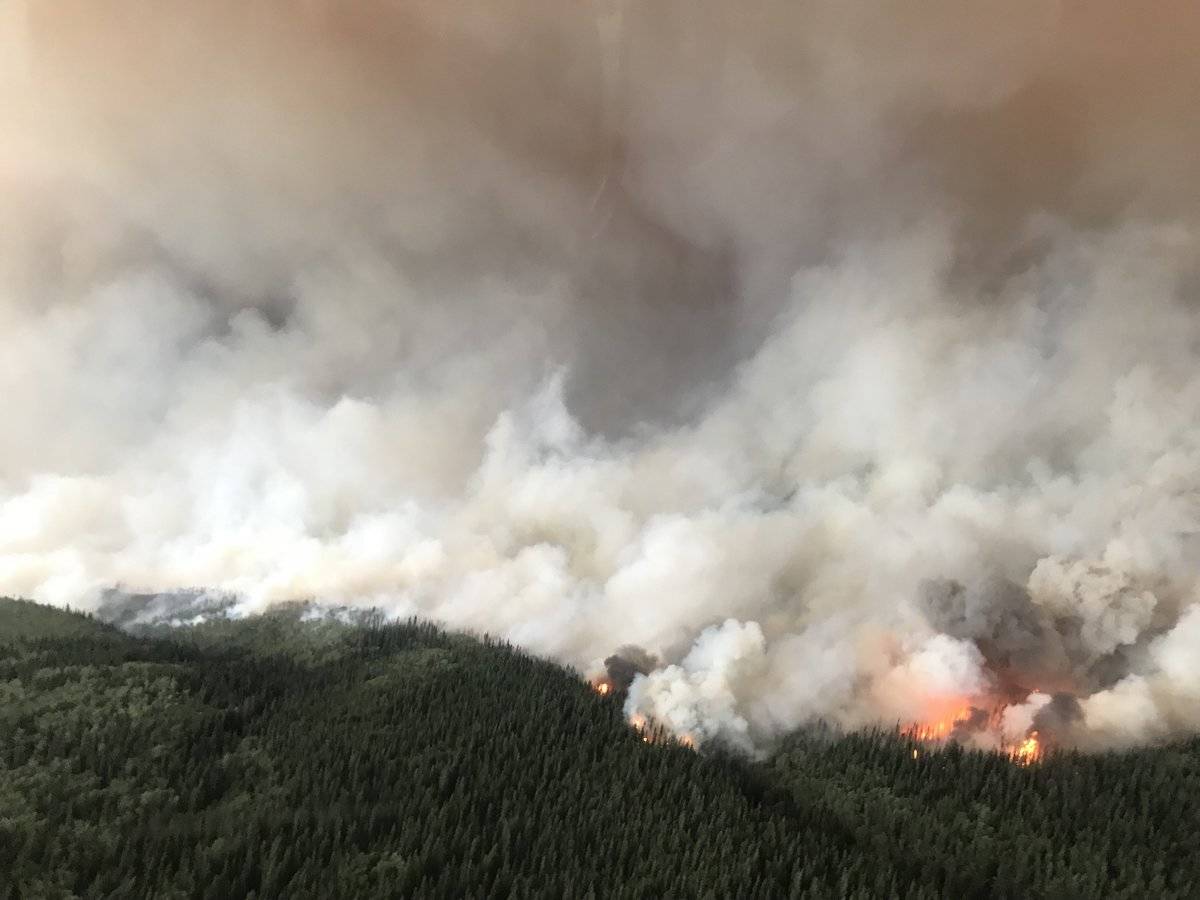UPDATE: 10 p..m. by the Canadian Press
Wildfires have ravaged 27 structures in Telegraph Creek, representing 30 to 45 per cent of buildings in the small northwestern British Columbia community, officials say.
Tahltan Band Chief Rick McLean said in a video posted to Facebook on Tuesday that the town has sustained significant damage, but fortunately no lives have been lost.
“That’s the town. We are the community. We are resilient, we’re going to lean on each other, and we’re going try to continue to fight the fight as best we can,” he said.
They don’t know yet which structures were destroyed, McLean said in the video recorded at a community hall on Tuesday morning and posted to a Facebook group created to distribute information about the wildfires.
Rick Boehm, emergency program co-ordinator at the Regional District of Kitimat-Stikine, said two large fires in the Telegraph Creek area likely merged on Tuesday afternoon to create a 150-square kilometre blaze.
He and McLean both said 27 structures had been lost to the flames.
BC Wildfire Service spokeswoman Heather Rice said the two fires in the area were running parallel and she had not received any information that they’d merged as of Tuesday evening.
Some of the impacted structures were merely damaged, rather than destroyed, she added.
The entire community of Telegraph Creek remains under an evacuation order. Residents living closer to Dease Lake were told on Tuesday to be prepared to leave at a moment’s notice, said Boehm.
Boehm, who is also chief of the Thornhill Fire Department, said heavy smoke has limited air craft in and out of the fire area. Workers are on the ground protecting what they can while equipment operators are clearing the road to allow firefighting equipment to re-enter, he said.
A new evacuation order was issued late Tuesday for several properties west of Topley in the Regional District of Bulkley-Nechako.
The district said the order covers properties primarily at the south end of Sunset Lake. Residents were asked to register at a reception centre at the College of New Caledonia in Burns Lake. The surrounding areas were also placed under an evacuation alert.
More than 460 wildfires are burning across the province. About 50 fires are burning in northwestern B.C., including the 78-square kilometre blaze that prompted the evacuation of Telegraph Creek.
“Some very high winds in the area, as well as continued dry conditions have been really challenging the efforts there,” said BC Wildfire Service spokeswoman Kyla Fraser.
Nearly 80 firefighters, nine helicopters and 15 pieces of heavy equipment are working on that fire alone, she said.
Lightning storms have abated after sparking hundreds of new wildfires in B.C. last week, but Fraser warned a renewed hot spell means no relief for firefighters.
Environment Canada issued heat warnings and special weather statements for large parts of B.C. on Tuesday, calling for temperatures up to 40 degrees in some areas by mid-week.
Conditions were not due to ease until Friday or Saturday, when the weather office said showers and cooling temperatures were likely.
The wildfire service currently lists the fire danger rating as high to extreme across much of the province, with most of northwestern B.C. and the inner south coast, including Vancouver Island, ranked as extremely dry.
Campfires have already been banned in many regions, and Haida Gwaii will join the list on Wednesday as will Prince George, Mackenzie and Fort St. James the following day.
An out-of-control blaze in a rural area of Vancouver Island, southwest of Nanaimo, prompted the Regional District of Nanaimo to declare a state of local emergency Monday night.
The nearly 1.5-square kilometre fire in the Nanaimo Lakes area broke out Sunday and grew aggressively Monday, forcing the evacuation of homes on its west flank and evacuation alerts for 77 properties on the east side.
With the evacuations on Vancouver Island, fires of concern are now burning in all six of B.C.’s regional fire centres.
In southeastern B.C., a 12-square kilometre blaze in Kootenay National Park has caused sporadic closures of Highway 93 and is being managed by Parks Canada and provincial wildfire staff.
Crews were making some progress containing a 120-square kilometre fire that forced evacuation of a wilderness lodge south of Princeton last week and the fire was 40 per cent contained on Tuesday, the wildfire service said.
Although the weather was not giving weary firefighters a break, Fraser said crews from outside the province were lending assistance.
“We have crews from Alberta, Northwest Territories and Saskatchewan that arrived last week. Last night we saw some firefighters from Mexico, as well as firefighters and support staff from New Zealand arriving,” she said.
Teams from Australia were expected to arrive in B.C. on Tuesday.
Forests Minister Doug Donaldson plans to speak with the finance minister about the annual wildfire budget and whether it needs to be revised, considering the increased number of wildfires the province has experienced in recent years, a spokeswoman said.
The budget for the 2018 wildfire season was $63 million, but $131 million has been spent to date.
The Canadian Press
—
ORIGINAL: 1 p.m.
Telegraph Creek residents were told today that 27 structures have been lost in a “volatile and aggressive wildfire” in northern B.C.
Evacuation Orders and Alerts are in effect for the Alkali Lake wildfire, first sparked on Aug. 1 about five kilometres northwest of Telegraph Creek.
The Tahltan Band held a meeting today at the Dease Lake Community Hall where residents were informed the fire has caused 35-40 per cent structural loss.
“Our town has sustained significant damages,” said Chief Rick Mclean in Tuesday morning’s meeting, before he took a moment to compose himself.
“But, there is no life lost. We are the community, that is the town, we are the community. We are resilient, we will lean on each other and we will continue to fight the fight best we can.
“The choppers are going in now as we speak. There’s no option of driving in. The fire did jump the river yesterday behind the ranch and there are significant fires, logs and trees on the highway, so there is no way to get vehicle access through there right now.”
The B.C. Wildfire Service reports both the 7,800-hectare Alkali Lake wildfire and the nearby 6,000-hectare Stikine River fire are burning out of control and crews are struggling to battle both the destructive blazes.
“We are continuing to see very volatile and aggressive fire behaviour on this fire, as well as the South Stikine fire,” said on-site fire information officer Heather Rice.
“These fires are really challenging our efforts so we are focusing our efforts on the town site itself, of Telegraph Creek.
Rice said the fire fight has been made more difficult by the extreme drought conditions and winds in the area.
“The area is currently exhibiting drought conditions that are incredibly unusual for this time of year and the wind. The wind is staying consistent, we are not seeing breaks in the wind that we often do overnight. The winds are continuing to blow through the night between 25 km/h and up to 50 km/h.
“Extreme drought and extreme wind. It is very dangerous fire behaviour at this point,” explained Rice.
“The fires are growing quite rapidly at this point. The firefighters are focusing their efforts at Telegraph Creek town site.”
As for the type of structures lost, Rice said that is still under investigation.
“We do not know the exact types of structures at this time, but it is still being investigated and will be reported to the community in the next few hours,” confirmed Rice.
“The structures were all lost in vicinity of the Telegraph creek area.”
Related: More crews moved to Alkali Lake wildfire
Related: Telegraph Creek under evacuation order
Related: Manning Park full when fire breaks out over long weekend
Residents near the fires should stay up to date on fire activity and changes to Evacuation Alerts and Orders by checking the BC Wildfires of Note page, as well as the Regional District of Kitimat-Stikine site and the Tahltan Band page.
“We want to thank the community of Dease Lake, they have been extremely helpful, as has the Tahltan Nation and we continue to work as hard as we can. We appreciate their support,” added Rice.
To report a typo, email:
newstips@kelownacapnews.com.
@carmenweld
carmen.weld@bpdigital.ca
Like us on Facebook and follow us on Twitter.

